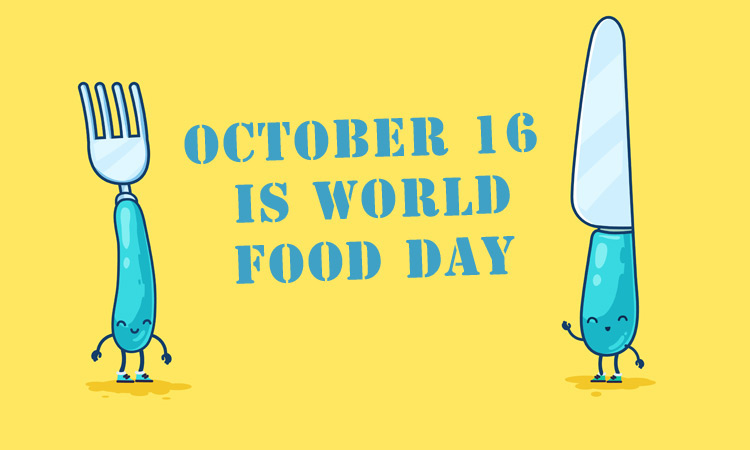 For many of us, one of autumn’s pleasures is taking a trip to a local farmers market overflowing with the abundant, colorful cornucopia of the season. It’s hard, perhaps, to imagine life without an abundance of food—yet, of course, that’s a reality facing many around the globe.
For many of us, one of autumn’s pleasures is taking a trip to a local farmers market overflowing with the abundant, colorful cornucopia of the season. It’s hard, perhaps, to imagine life without an abundance of food—yet, of course, that’s a reality facing many around the globe.
World Food Day, held every October 16, and first established in 1979 by the Food and Agriculture Organization of the United Nations (FAO), serves as a reminder that hunger and malnutrition continue to be problems of epidemic proportion in many parts of the globe.
Food insecurity
The FAO states that hunger kills more people every year than malaria, tuberculosis and AIDS combined. One-third of the food produced in the world for human consumption every year—approximately 1.3 billion tons, the FAO reports, is lost or wasted. And under-nutrition is a factor in more than a third of the deaths of all children under age five.
And “in the U.S., one of the richest countries in the world, one in seven Americans—14.3%—does not have enough to eat.” For those impacted by economic difficulty, nutritious food and a balanced diet can simply cost too much.
Power plays
But is the issue simply not enough food to go around? No, Oxfam America, a global organization fighting poverty, hunger and injustice, notes that, “Hunger isn’t about too many people and too little food. It’s about power, and its roots lie in inequalities in access to resources and opportunities.”
Gender inequality also gives rise to hunger. If women farmers had the same access to resources as men, the FAO states, “the number of hungry people in the world could be reduced by up to 150 million.”
A changing planet
Global warming’s effect on arable land, diminishing water supplies and land grabs can also be consequential. Timothy Snyder, a professor at Yale University notes in a recent New York Times’ opinion piece, The Next Genocide, that “The Chinese leadership already regards Africa as a long-term source of food. Although many Africans themselves still go hungry, their continent holds about half of the world’s untilled arable land. Like China, the United Arab Emirates and South Korea are interested in Sudan’s fertile regions—and they have been joined by Japan, Qatar and Saudi Arabia in efforts to buy or lease land throughout Africa.”
Investing in agriculture
Is there a solution? Oxfam America notes that, “Although the number of hungry people in the world has fallen by 17 percent over the past quarter century, 795 million people still do not have enough to eat. And, despite recent gains, the overall trend during the past 30 years has been a massive reduction in investment in agriculture in the developing world.”
Oxfam’s efforts to counter this include robust investment in agriculture development, fair farm labor practices, greater emphasis on food security and responsible stewardship of natural resources.
In 2013, Oxfam also established a rural resilience program in Senegal to help farmers minimize the risk of poor harvests by organizing growers to build rock walls to reduce erosion, a seemingly simple measure which has helped farmers triple their rice harvests from 100 to 300 kilos.
Focusing on a whole food plant based diet
Some believe the solution lies in a vegan diet. PETA (People for the Ethical Treatment of Animals) advocates veganism as a way to fight world hunger, and cites a study at the University of Minnesota’s Institute on the Environment, which found “that growing crops for direct human consumption increases available food calories by up to 70 percent and that the newly freed-up crops would be enough to feed an additional 4 billion people. That’s more than enough food to cover the estimated increase in world population of 2 to 3 billion people by 2050.”
PETA also supports the development of commercially viable in-vitro (test tube) sources of protein to replace the slaughter of animals. While the future may one day have burgers that never moo’d, we likely won’t find test tube meat at Whole Foods anytime soon.
Will we ever see an end to world hunger?
The world produces enough food to feed every person on the planet, the FAO states. World leaders signed a commitment in September 2000 to achieve eight Millennium Development Goals by 2015. Forty countries have already achieved the first target of Millennium Development Goal #1, the FAO notes, to eradicate extreme poverty and hunger by halving the proportion of people who suffer from hunger by 2015. While there is still a long way to go, with a worldwide focus and much effort, perhaps it will be possible to end hunger in our lifetime.
If you would like to learn more or contribute to the fight against hunger, visit Oxfam America, City Harvest or Feed the Children.
Click here to find out about Rose’s thoughts on wellbeing and health
Post Disclaimer
This content is for informational purposes only and does not constitute medical advice. Please consult a healthcare professional for any medical concerns.


